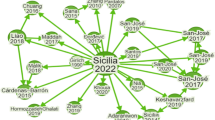Abstract
Performance impacts of ordering and production control policies in the presence of capacity disruptions are studied on the real-life example of a retail supply chain with product perishability considerations. Constraints on product perishability typically result in reductions in safety stock and increases in transportation frequency. Consideration of the production capacity disruption risks may lead to safety stock increases. This trade-off is approached with the help of a simulation model that is used to compare supply chain performance impacts with regard to coordinated and non-coordinated ordering and production control policies. Real data of a fast moving consumer goods company is used to perform simulations and to derive novel managerial insights and practical recommendations on inventory, on-time delivery and service level control. In particular, for the first time, the effect of ‘postponed redundancy’ has been observed. Moreover, a coordinated production–ordering contingency policy in the supply chain within and after the disruption period has been developed and tested to reduce the negative impacts of the ‘postponed redundancy’. The lessons learned from experiments provide evidence that a coordinated policy is advantageous for inventory dynamics stabilization, improvement in on-time delivery, and variation reduction in customer service level.






Similar content being viewed by others
References
Agnetis, A., Detti, P., Meloni, C., & Pacciarelli, D. (2001). Set-up coordination between two stages of a supply chain. Annals of Operations Research, 107(1–4), 15–32.
Ambulkar, S., Blackhurst, J., & Grawe, S. (2015). Firm’s resilience to supply chain disruptions: Scale development and empirical examination. Journal of Operations Management, 33(34), 111–122.
Amorim, P., Meyr, H., Almeder, C., & Almada-Lobo, B. (2013). Managing perishability in production–distribution planning: A discussion and review. Flexible Services and Manufacturing Journal, 25(3), 389–413.
Atan, Z., & Snyder, L. V. (2012a). Inventory strategies to manage supply disruptions. In H. Gurnani, A. Mehrotra, S. Ray (Eds.), Supply disruptions: Theory and practice of managing risk (pp. 115–139). New York: Springer.
Atan, Z., & Snyder, L. V. (2012b). Disruptions in one-warehouse multiple-retailer systems. SSRN. http://ssrn.com/abstract=2171214.
Atan, Z., & Snyder, L. V. (2013). EOQ models with supply disruptions. In T. -M. Choi (Ed.), Handbook of EOQ inventory problems (Vol. 197, pp. 43–55). New York: Springer.
Azad, N., Saharidis, G. K. D., Davoudpour, H., Malekly, H., & Yektamaram, S. A. (2013). Strategies for protecting supply chain networks against facility and transportation disruptions: An improved Benders decomposition approach. Annals of Operations Research, 210(1), 125–163.
Bakker, M., Riezebos, J., & Teunter, R. H. (2012). Review of inventory systems with deterioration since 2001. European Journal of Operational Research, 221(2), 275–284.
Blackburn, J., & Scudder, G. (2009). Supply chain strategies for perishable products: The case of fresh produce. Production and Operations Management, 18(2), 129–137.
Boone, C., Craighead, C., Hanna, J., & Nair, A. (2013). Implementation of a system approach for enhanced supply chain continuity and resiliency: A longitudinal study. Journal of Business Logistics, 34(3), 220–232.
Carvalho, H., Azevedo, S. G., & Cruz-Machado, V. (2012a). Agile and resilient approaches to supply chain management: Influence on performance and competitiveness. Logistics Research, 4(1–2), 49–62.
Carvalho, H., Barroso, A. P., Machado, V. H., Azevedo, S., & Cruz-Machado, V. (2012b). A supply chain redesign for resilience using simulation. Computers and Industrial Engineering, 62, 329–341.
Chen, H., Chen, Y. F., Chiu, C.-H., Choi, T.-M., & Sethi, S. (2010). Coordination mechanism for the supply chain with leadtime consideration and price-dependent demand. European Journal of Operational Research, 203(1), 70–80.
Chen, F., Federgruen, A., & Zheng, Y.-S. (2001). Coordination mechanisms for a distribution system with one supplier and multiple retailers. Management Science, 47(5), 693–708.
Chiu, C.-H., Choi, T.-M., & Li, X. (2011). Supply chain coordination with risk sensitive retailer under target sales rebate. Automatica, 47(8), 1617–1625.
Choi, T. M., Cheng, T. C. E., & Zhao, X. (2016). Multi-methodological research in operations management. Production and Operations Management, 25, 379–389.
Cordeau, J. F., Pasin, F., & Solomon, M. M. (2006). An integrated model for logistics network design. Annals of Operations Research, 144(1), 59–82.
Craighead, C. W., Blackhurst, J., Rungtusanatham, M. J., & Handfield, R. B. (2007). The severity of supply chain disruptions: Design characteristics and mitigation capabilities. Decision Sciences, 38(1), 131–156.
DuHadway, S., Carnovale, S., & Hazen, B. (2017). Understanding risk management for intentional supply chain disruptions: Risk detection, risk mitigation, and risk recovery. Annals of Operations Research. doi:10.1007/s10479-017-2452-0
Entrup, L., Gunther, M., van Beek, H.-O., Grunow, P., & Seiler, M. (2005). Mixed-integer linear programming approaches to shelf-life: Integrated planning and scheduling in yoghurt production. International Journal of Production Research, 43(23), 5071–5100.
Fahimnia, B., Tang, C. S., Davarzani, H., & Sarkis, J. (2016). Quantitative models for managing supply chain risks: A review. European Journal of Operational Research, 247(1), 1–15.
Ferguson, M., & Ketzenberg, M. E. (2006). Information sharing to improve retail product freshness of perishables. Production and Operations Management, 15(1), 57–73.
Fu, H., Ma, Y., Ni, D., & Cai, X. (2015). Coordinating a decentralized hybrid push–pull assembly system with unreliable supply and uncertain demand. Annals of Operations Research. doi:10.1007/s10479-015-1865-x (in press).
Gan, X., Sethi, S. P., & Yan, H. (2004). Coordination of supply chains with risk-averse agents. Production and Operations Management, 13(2), 135–149.
Goyal, S. K., & Giri, B. C. (2001). Recent trends in modeling of deteriorating inventory. European Journal of Operational Research, 134, 1–16.
Heydari, J., & Asl-Najafi, Ja. (2016). Coordinating inventory decisions in a two-echelon supply chain through the target sales rebate contract. International Journal of Inventory Research, 3(1), 49–68.
Ivanov, D. (2017). Simulation-based ripple effect modelling in the supply chain. International Journal of Production Research, 55(7), 1083–1101.
Ivanov, D., Pavlov, A., & Sokolov, B. (2014a). Optimal distribution (re)planning in a centralized multi-stage supply network under conditions of the ripple effect and structure dynamics. European Journal of Operational Research, 237, 758–770.
Ivanov, D., Sokolov, B., & Dolgui, A. (2014b). The ripple effect in supply chains: Trade-off ‘efficiency-flexibility-resilience’ in disruption management. International Journal of Production Research, 52(7), 2154–2172.
Ivanov, D., Sokolov, B., Dolgui, A., Solovyeva, I., & Jie, F. (2016a). Dynamic recovery policies for time-critical supply chains under conditions of ripple effect. International Journal of Production Research, 54(23), 7245–7258.
Ivanov, D., Sokolov, B., Pavlov, A., Dolgui, A., & Pavlov, D. (2016b). Disruption-driven supply chain (re)-planning and performance impact assessment with consideration of pro-active and recovery policies. Transportation Research Part E: Logistics and Transportation Review, 90, 7–24.
Ivanov, D., Tsipoulanidis, A., & Schönberger, J. (2017). Global supply chain and operations management: A decision-oriented introduction into the creation of value. Berlin: Springer.
Jayaraman, V., & Pirkul, H. (2001). Planning and coordination of production and distribution facilities for multiple commodities. European Journal of Operational Research, 133(2), 394–408.
Karaesmen, I. Z., Scheller-Wolf, A., & Deniz, B. (2011). Managing perishable and aging inventories: Review and future research directions. International Series in Operations Research and Management Science, 151, 393–436.
Kim, S. H., & Tomlin, B. (2013). Guilt by association: Strategic failure prevention and recovery capacity investments. Management Science, 59(7), 1631–1649.
Kleindorfer, P. R., & Saad, G. H. (2005). Managing disruption risks in supply chains. Production and Operations Management, 14(1), 53–68.
Klibi, W., Martel, A., & Guitouni, A. (2010). The design of robust value-creating supply chain networks: A critical review. European Journal of Operational Research, 203(2), 283–293.
Kouvelis, P., & Li, J. (2012). Contingency strategies in managing supply systems with uncertain lead-times. Production and Operations Management, 21(1), 161–176.
Leat, P., & Revoredo-Giha, C. (2013). Risk and resilience in agri-food supply chains: The case of the ASDA PorkLink supply chain in Scotland. Supply Chain Management: An International Journal, 18(2), 219–231.
Lewis, B. M., Erera, A. L., Nowak, M. A., & White, C. C, I. I. I. (2013). Managing inventory in global supply chains facing port-of-entry disruption risks. Transportation Science, 47(2), 162–180.
Li, X., & Wang, Q. (2007). Coordination mechanisms of supply chain systems. European Journal of Operational Research, 179(1), 1–16.
Nagurney, A., Yu, M., Masoumi, A. H., & Nagurney, L. S. (2013). Networks against time. Supply chain analytics for perishable products. New York: Springer.
Nahmias, S. (1980). Perishable inventory theory: A review. Operations Research, 30(4), 680–708.
Pahl, J., & Voß, S. (2014). Integrating deterioration and lifetime constraints in production and supply chain planning: A survey. European Journal of Operational Research, 238(3), 654–674.
Qi, X., Bard, J. F., & Yu, G. (2004). Supply chain coordination with demand disruptions. Omega, 32(4), 301–312.
Rice, J. B., & Caniato, F. (2003). Building a secure and resilient supply network. Supply Chain Management Review, 7, 22–30.
Schmitt, A. J., & Singh, M. (2012). A quantitative analysis of disruption risk in a multi-echelon supply chain. International Journal of Production Economics, 139, 22–32.
Schmitt, A. J., Sun, S. A., Snyder, L. V., & Shen, Z.-J. M. (2015). Centralization versus decentralization: Risk pooling, risk diversification, and supply chain disruptions. Omega, 52, 201–212.
Sheffi, Y., & Rice, J. (2005). A supply chain view of the resilient enterprise. MIT Sloan Management Review, 47, 41–48.
Simchi-Levi, D., Schmidt, W., Wei, Y., Zhang, P. Y., Combs, K., Ge, Y., et al. (2015). Identifying risks and mitigating disruptions in the automotive supply chain. Interfaces, 45(5), 375–390.
Snyder, L. V., Atan, Z., Peng, P., Rong, Y., Schmitt, A. J., & Sinsoysal, B. (2016). OR/MS models for supply chain disruptions: A review. IIE Transactions, 48(2), 89–109.
Snyder, L. V., & Daskin, M. S. (2005). Reliability models for facility location: The expected failure cost case. Transportation Science, 39, 400–416.
Song, J.-S., & Zipkin, P. (2009). Inventories with multiple supply sources and networks of queues with overflow bypasses. Management Science, 55(3), 362–372.
Spiegler, V. L., Naim, M. M., Towill, D. R., & Wikner, J. (2016). A technique to develop simplified and linearised models of complex dynamic supply chain systems. European Journal of Operational Research, 251(3), 888–903.
Tomlin, B. (2006). On the value of mitigation and contingency strategies for managing supply chain disruption risks. Management Science, 52(5), 639–657.
Tomlin, B. (2009). Disruption-management strategies for short life-cycle products. Naval Research Logistics, 56, 318–347.
Wagner, H. M., & Whitin, T. (1958). Dynamic version of the economic lot size model. Management Science, 5, 89–96.
Xiao, T., Yu, G., Sheng, Z., & Xia, Y. (2005). Coordination of a supply chain with one-manufacturer and two-retailers under demand promotion and disruption management decisions. Annals of Operations Research, 135(1), 87–109.
Xu, M., Wang, X., & Zhao, L. (2014). Predicted supply chain resilience based on structural evolution against random supply disruptions. International Journal of Systems Science: Operations and Logistics, 1(2), 105–117.
Yang, Z., Aydin, G., Babich, V., & Beil, D. (2009). Supply disruptions, asymmetric information, and a backup production option. Management Science, 55(2), 192–209.
Zijm, H., & Timmer, J. (2008). Coordination mechanisms for inventory control in three-echelon serial and distribution systems. Annals of Operations Research, 158(1), 161–182.
Acknowledgements
The author thanks Guest Editor and anonymous reviewers for their valuable comments that greatly improved the manuscript. We cordially thank Mr. John Davis, lecturer in operations management and research associate at Berlin School of Economics and Law for a thorough proof-reading of this manuscript.
Author information
Authors and Affiliations
Corresponding author
Rights and permissions
About this article
Cite this article
Ivanov, D., Rozhkov, M. Coordination of production and ordering policies under capacity disruption and product write-off risk: an analytical study with real-data based simulations of a fast moving consumer goods company. Ann Oper Res 291, 387–407 (2020). https://doi.org/10.1007/s10479-017-2643-8
Published:
Issue Date:
DOI: https://doi.org/10.1007/s10479-017-2643-8




